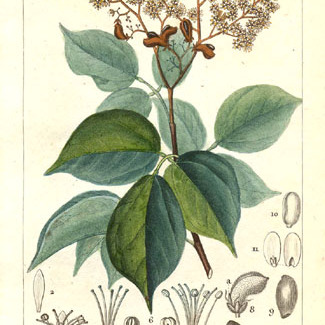Lianas (sometimes scrambling shrubs). Leaves trifoliolate. Inflorescences axillary, pseudo-terminal, or truly terminal, paniculate, usually some of the main branches nearly equally strongly developed. Bracts and bracteoles rather persistent, bracts terete, slightly thickened at the apex, bracteoles narrowly linear. Flowers bisexual, (4-)5-merous. Sepals outside minutely tomentose, inside short-appressed-pubescent. Petals linear, distinctly exceeding the sepals, glabrous. Stamens 10(-5), slightly connate at the base, episepalous ones distinctly longer than epipetalous ones, the latter rarely fully absent. Pistils 5 (rarely, specially in African spp., some more, which are often sterile), heterodi-or-tristylous; ovary and style-base pubescent; style cylindrical; stigma minute, 3-lobed. Fruits not rarely more than 1 per flower, usually strongly recurved; sustained by the persistent, not accrescent calyx, often tuberculate, more or less densely tomentose, red when ripe, opening by a lengthwise slit; pericarp rather thin. Seed 1, shining black, partly covered by an orange or yellow arilloid; endosperm none.
Climbing shrubs, small trees or lianes; young branches, inflorescences, etc., usually with stiff fascicled hairs. Leaves trifoliolate, leaflets usually entire, lateral leaflets oblique. Inflorescence a large terminal or axillary many-flowered panicle. Flowers pentamerous, androecium and gynoecium heteromorphic. Sepals imbricate, with dense brown indumentum, usually fringed with glandular hairs. Petals longer than sepals, often slightly connate at base, glabrous. Filaments connate at base, terete, glabrous. Carpels pilose; stigma expanded and sometimes flattened; ovules basally inserted. Fruit an obovoid or pyriform follicle, base constricted; dehiscence by ventral suture, pericarp peeling and curling back to expose seed; pericarp velutinous. Seed ± ovoid, testa dark and shining; aril basal, obliquely cupuliform, somewhat fleshy, cotyledons plano-convex, radicle apical, endosperm nil.
Seed ± ovoid, testa dark and shining; aril basal, obliquely cupuliform; cotyledons plano-convex, radicle apical; endosperm absent.
Sepals imbricate, with a dense brown indumentum, usually fringed with glandular hairs.
Carpels pilose; stigma expanded and sometimes flattened; ovules basally inserted.
Petals longer than the sepals, often slightly connate near the base, glabrous.
Woody lianes, scandent shrubs or small trees; usually with fascicled hairs.
Fruit 1–3-follicular; dehiscence by the ventral suture; pericarp tomentose.
Flowers 5-merous; androecium and gynoecium heteromorphic.
Filaments connate at the base, terete, glabrous.
Inflorescence a large many-flowered panicle.
Leaves 3-foliolate.

